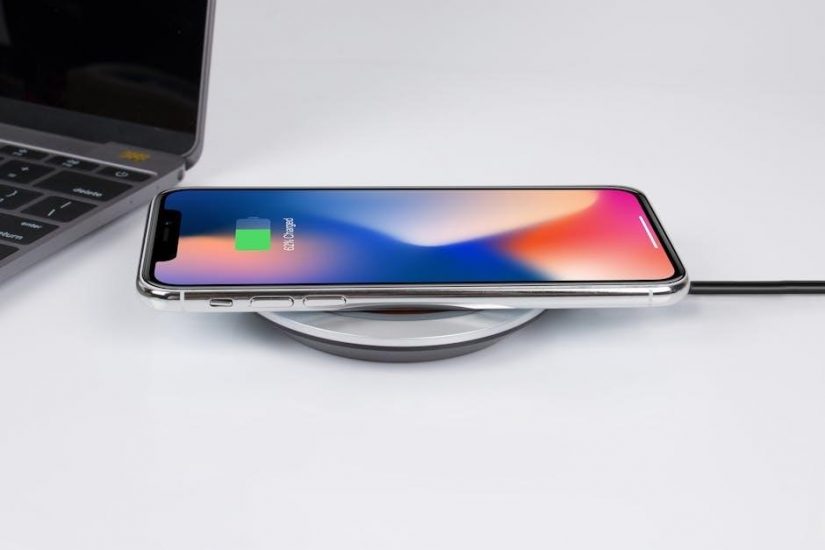Welcome to the Schumacher Battery Chargers manual! This guide provides essential information on safe operation, key features, and troubleshooting for optimal battery maintenance and charging.
1.1 Overview of Schumacher Battery Chargers
Schumacher Battery Chargers are versatile, reliable devices designed to charge, maintain, and extend the life of various battery types, including lead-acid, AGM, and gel batteries. These chargers cater to both automotive and industrial applications, offering fully automatic and manual charging options. Models like the FR01576 and SC1632 feature advanced functionalities such as overcharge protection, maintenance modes, and engine starter capabilities. Known for their durability and user-friendly interfaces, Schumacher chargers are ideal for professionals and hobbyists alike. They ensure safe and efficient charging, with clear indicators and adjustable settings to suit different battery needs. Whether for vehicles, RVs, or equipment, Schumacher chargers provide consistent performance and long-term reliability.
1.2 Importance of Using a Manual
Using a Schumacher Battery Charger manual is crucial for safe and effective operation. It provides essential safety precautions, detailed charging instructions, and troubleshooting guidance. The manual ensures users understand how to handle lead-acid, AGM, and gel batteries properly, avoiding risks like electric shock or fire. It also explains how to utilize advanced features such as overcharge protection and maintenance modes. By following the manual, users can extend battery life and prevent damage to the charger or vehicle. Additionally, it covers warranty details and customer support information, ensuring users are protected and informed. Always refer to the manual before operating to guarantee optimal performance and safety.

Safety Precautions
Always follow safety guidelines to prevent hazards. Avoid exposing the charger to water, use only recommended attachments, remove grounded terminals first, and ensure all vehicle accessories are off to ensure safe operation.
2.1 General Safety Guidelines
Always read and follow the instructions carefully before using the Schumacher battery charger. Ensure the charger is used in a well-ventilated area, away from water and flammable materials. Avoid exposing the charger to rain or snow, as it may cause electric shock or fire hazards. Never use attachments not recommended by the manufacturer, as this could lead to safety risks. When disconnecting the battery, remove the grounded terminal first to prevent arcing. Keep the charger out of reach of children and ensure all vehicle accessories are turned off during charging to avoid electrical issues. Properly maintain the charger and battery terminals to ensure safe and efficient operation. Always prioritize safety to prevent accidents and prolong the lifespan of your battery and charger.
2.2 Important Warnings and Cautions
Always use the Schumacher battery charger solely for lead-acid, AGM, or gel batteries, as specified in the manual. Never use it for dry-cell or non-rechargeable batteries, as this may cause bursting or injury. Avoid overcharging, as it can damage the battery or lead to safety hazards. Do not modify the charger or use unauthorized attachments, as this could result in fire or electrical shock. Ensure the charger is not exposed to water or extreme temperatures. Keep the area well-ventilated to prevent hydrogen gas buildup. Never leave the charger unattended while in use, and always monitor the charging process to avoid overcharging. Wear protective eyewear when handling batteries to prevent acid splashes. Follow all safety guidelines carefully to ensure safe and effective charging.
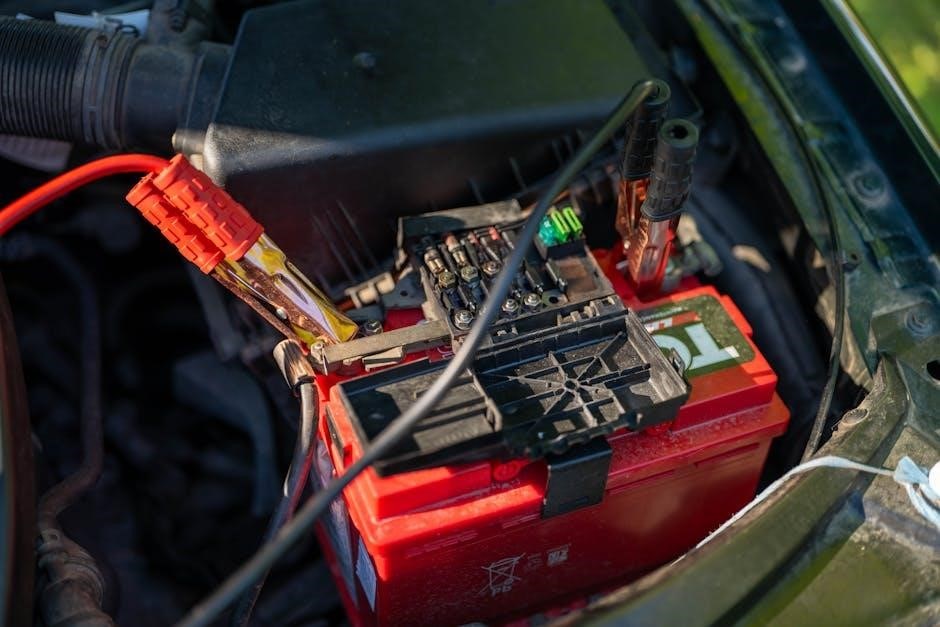
Key Features of Schumacher Battery Chargers
Schumacher chargers offer compatibility with lead-acid, AGM, and gel batteries, automatic and manual charging modes, and advanced safety features like overcharge protection for reliable performance.
3.1 Compatible Battery Types (Lead-Acid, AGM, Gel)
Schumacher battery chargers are designed to work seamlessly with various battery types, including lead-acid, AGM (Absorbent Glass Mat), and gel batteries. Lead-acid batteries are the most common, ideal for standard vehicles and equipment. AGM batteries, known for their maintenance-free design, are suited for deep-cycle applications and off-grid systems. Gel batteries offer excellent deep-cycling capabilities and are perfect for extreme temperatures. Schumacher chargers automatically detect and adapt to the battery type, ensuring optimal charging and maintenance. This versatility makes them a reliable choice for automotive, marine, and industrial applications. The chargers also feature advanced safety protections to prevent overcharging, making them suitable for long-term battery health and performance.
3.2 Charging Modes and Settings
Schumacher battery chargers offer multiple charging modes to cater to different battery needs. The Fast Charge mode quickly replenishes battery power, ideal for deeply discharged batteries. Slow Charge mode is designed for maintenance and small batteries, ensuring gentle charging to prevent overcharging. Many models also feature an automatic setting that detects battery type and adjusts charging parameters accordingly. Additionally, some chargers include a Maintenance Mode for long-term storage, keeping batteries at full charge without overcharging. Advanced models like the SC1632 support both 6V and 12V batteries, with customizable settings for precise charging control. These versatile modes ensure optimal charging for various applications, making Schumacher chargers suitable for automotive, marine, and industrial use. The chargers also include overcharge protection and automatic shut-off for added safety.
3.4 Automatic and Manual Charging Options
Schumacher battery chargers provide both automatic and manual charging options to suit different user preferences and needs. The automatic mode is ideal for hassle-free charging, as it detects battery type (6V or 12V) and adjusts settings accordingly, ensuring safe and efficient charging. Manual mode offers greater control, allowing users to set specific charge rates and parameters for specialized applications or deeply discharged batteries. This dual functionality caters to both novice users who prefer simplicity and professionals requiring precise control. Switching between modes is straightforward, and the charger ensures overcharge protection in both settings for added safety and battery longevity. These options make Schumacher chargers versatile and user-friendly for various charging scenarios.

Installation and Setup
Proper installation and setup ensure safe and efficient charging. Choose a well-ventilated, dry location away from flammable materials. Ensure the charger is placed on a stable surface and connected correctly to avoid electrical hazards. Always follow the manual’s guidelines for wiring and connections to prevent damage or safety risks.
4.1 Choosing the Right Location for the Charger
When selecting a location for your Schumacher battery charger, ensure it is well-ventilated, dry, and away from flammable materials. Avoid placing it in direct sunlight or humid environments to prevent overheating and electrical hazards. The charger should be positioned on a stable, flat surface to maintain balance and prevent accidental tipping. Keep it away from children and pets to avoid unintended tampering. Additionally, choose a location that allows easy access for monitoring and maintenance. Proper placement ensures safe and efficient charging while adhering to safety guidelines outlined in the manual.
4.2 Step-by-Step Installation Guide
Begin by unpacking the Schumacher battery charger and ensuring all components are included. Choose a well-ventilated, dry location away from flammable materials. Connect the charger to the battery, starting with the positive terminal and then the negative. Ensure all vehicle accessories are turned off to prevent electrical surges. Plug the charger into a nearby power outlet and select the appropriate charging mode based on your battery type. Monitor the charging process using the built-in indicators or display. Once charging is complete, disconnect the charger and store it in a cool, dry place. Always refer to the manual for specific instructions tailored to your charger model for optimal performance and safety.
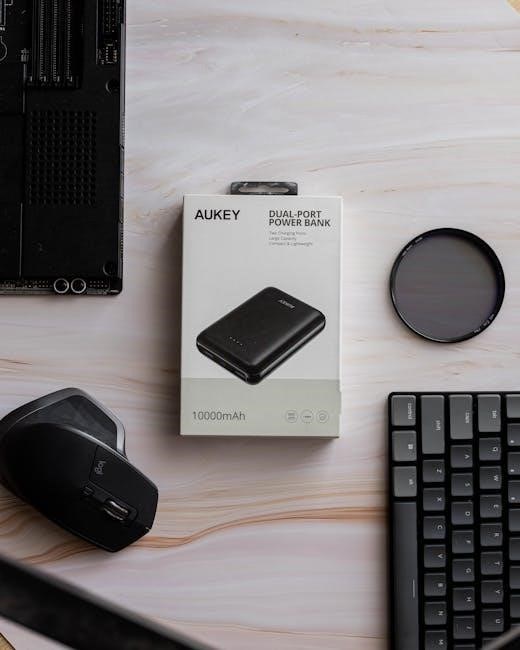
Operating the Schumacher Battery Charger
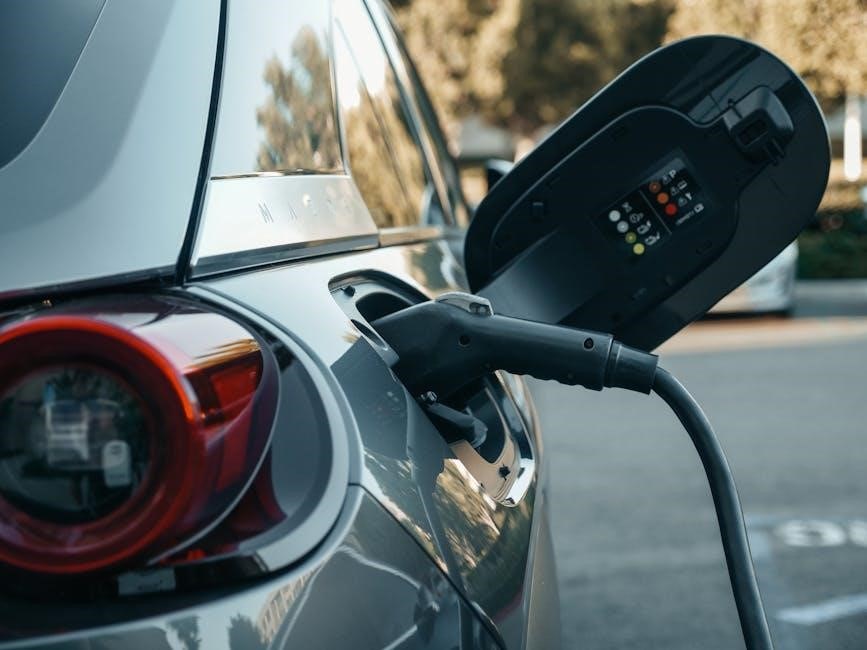
Operating the Schumacher charger involves selecting the correct mode, monitoring progress via indicators, and adjusting settings as needed for safe and efficient charging, ensuring optimal battery health.
5.1 Understanding the Charging Process
Understanding the charging process is essential for optimal use of your Schumacher battery charger. The charger is designed to work with lead-acid, AGM, and gel batteries, ensuring compatibility with various applications. Upon connection, the charger automatically diagnoses the battery’s condition and selects the appropriate charging mode. It features multiple charging phases, including bulk, absorption, and maintenance, to ensure a safe and efficient charge. The charger also includes overcharge protection to prevent battery damage. For manual charging, users can select specific settings based on battery type and capacity. Always refer to the manual for detailed instructions on selecting the correct charge rate and monitoring the charging status to ensure proper operation and battery longevity.
5.2 Selecting the Correct Charge Rate
Selecting the correct charge rate is crucial for efficient and safe battery charging. Schumacher battery chargers offer multiple charge rate settings to accommodate different battery types and sizes. Always refer to the manual for specific recommendations based on your battery’s capacity and chemistry. For most lead-acid batteries, a charge rate of 10-20% of the battery’s amp-hour rating is ideal. AGM and gel batteries may require lower charge rates to prevent damage. Adjusting the charge rate incorrectly can lead to overcharging or undercharging, which can shorten battery life. Ensure the charger is set to match your battery’s specifications before starting the charging process. Proper selection ensures optimal performance and longevity of your battery.
5.3 Monitoring the Charging Status
Monitoring the charging status is essential to ensure your battery charges safely and efficiently. Schumacher battery chargers are equipped with LED indicators or digital displays that show the current charging mode, such as bulk, absorption, or maintenance. Always check the charger’s display periodically to confirm the charge progress. Refer to the manual for specific indicator meanings, as they may vary by model. Ensure the battery terminals remain clean and secure during charging to maintain proper connectivity. If you notice unusual behavior, such as excessive heat or slow charging, stop the process and troubleshoot. Proper monitoring helps prevent overcharging, extends battery life, and ensures reliable performance. Keep the charger in a well-ventilated area to avoid overheating and always follow safety guidelines.
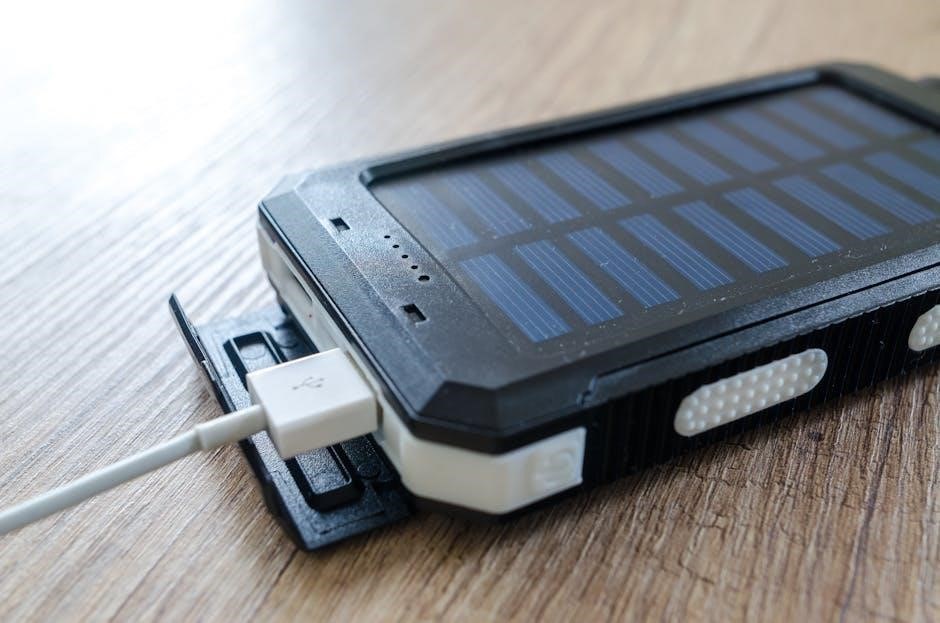
Maintenance and Care
Regularly clean battery terminals and the charger to ensure proper conductivity. Store both in a cool, dry place away from direct sunlight. Inspect cables and connections routinely for wear.
6.1 Cleaning the Charger and Battery Terminals
Cleaning the Schumacher battery charger and terminals is essential for maintaining proper function. Use a wire brush to remove corrosion from terminal clamps and battery posts. Dampen a cloth with water and gently wipe the charger’s exterior to avoid moisture ingress. Avoid harsh chemicals, as they may damage components. For tougher corrosion, mix baking soda and water to create a paste, apply it to the terminals, and scrub gently before rinsing with water. Ensure all surfaces are dry before reconnecting the battery. Regular cleaning prevents electrical issues and ensures safe, efficient charging. Always disconnect the battery before cleaning to avoid short circuits or electric shock.
6.2 Storing the Charger and Battery
Proper storage of your Schumacher battery charger and battery is crucial for maintaining their performance and longevity. Store the charger in a cool, dry, well-ventilated area, away from direct sunlight and moisture; When storing the battery, ensure it is fully charged to prevent sulfation. Disconnect the battery terminals to avoid any parasitic drain. Place the battery on a stable, non-conductive surface, such as a plastic or wooden shelf. Avoid extreme temperatures, as they can degrade the battery’s capacity. For long-term storage, consider using the charger’s maintenance mode to keep the battery at an optimal charge level. Always follow the manufacturer’s guidelines for storage to ensure safety and reliability.
6.3 Troubleshooting Common Issues
Troubleshooting your Schumacher battery charger involves identifying common issues and resolving them effectively. If the charger does not turn on, check the power supply and ensure all connections are secure. For a battery that won’t charge, verify that the correct charge rate is selected and that the battery terminals are clean. If the charger overheats, ensure proper ventilation and avoid overloading. For maintenance mode issues, consult the manual to ensure the setting is correctly applied. If problems persist, refer to the warranty information or contact Schumacher customer support for assistance. Regular maintenance and adherence to safety guidelines can prevent many of these issues.
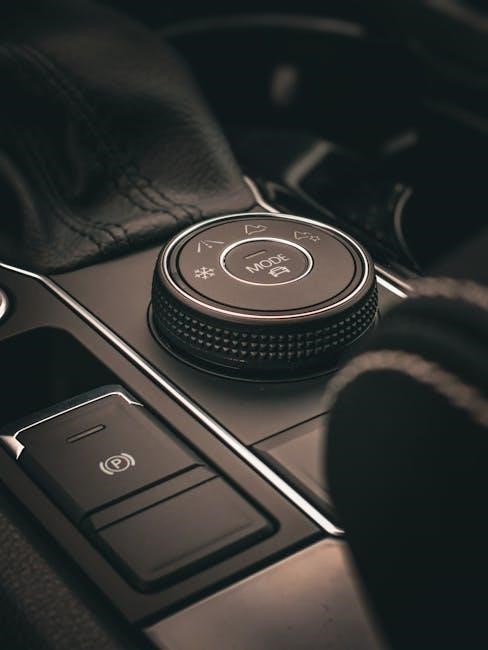
Advanced Features of Schumacher Chargers
Schumacher chargers offer advanced features like engine starter function, maintenance mode for long-term storage, and overcharge protection, ensuring versatility and reliability for various battery types and applications.

7.1 Engine Starter Function
The Schumacher battery charger features an engine starter function, designed to jump-start vehicles in emergency situations. This function provides a high surge of power to start engines with deeply discharged batteries. It is essential to use this feature only in emergencies and follow the manual’s safety guidelines to avoid potential hazards. Always ensure the charger is properly connected to the battery terminals, with the grounded terminal disconnected first to prevent sparks. The engine starter function is a convenient and powerful tool for drivers, offering reliability and peace of mind during unexpected battery failures. Proper usage ensures safe and effective engine starting without damaging the charger or vehicle electrical systems.
7.2 Maintenance Mode for Long-Term Storage
The Schumacher battery charger includes a maintenance mode designed for long-term battery storage. This feature ensures batteries remain fully charged without overcharging, making it ideal for seasonal vehicles, boats, or RVs. The charger monitors the battery’s state and adjusts the charge rate to maintain optimal levels. It is compatible with lead-acid, AGM, and gel batteries, providing a reliable solution for extended storage. For best results, store the battery in a cool, dry place and check its condition periodically. Always follow the manual’s guidelines for maintenance mode to ensure safety and efficiency. This feature prevents battery degradation, keeping your battery ready for use when needed.
7.3 Overcharge Protection and Safety Features
Schumacher battery chargers are equipped with advanced overcharge protection and safety features to prevent battery damage and ensure safe operation. These chargers automatically detect when a battery is fully charged and switch to a maintenance mode, avoiding overcharging. They also feature thermal overload protection, which shuts down the charger if it overheats. Additionally, many models include reverse polarity protection to prevent electrical damage if cables are connected incorrectly. These safety features provide peace of mind, protecting both the battery and the charger from potential harm. Regular use of these protective functions ensures longevity and reliability for your battery and charging system.
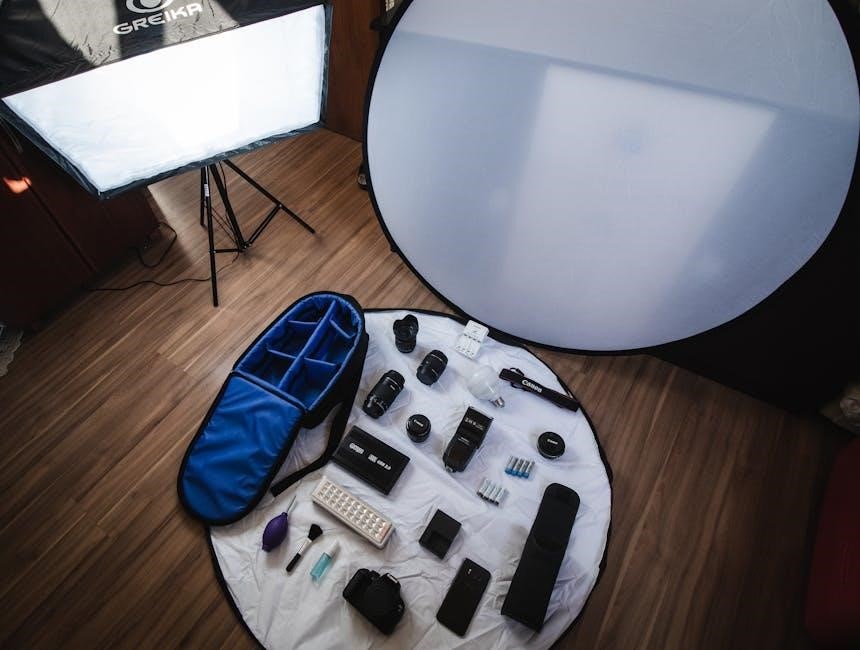
Warranty and Support
Schumacher Electric Corporation provides a two-year warranty on battery chargers. Contact customer service for support, repairs, or warranty claims through their official website or phone support.
8.1 Warranty Coverage and Duration
Schumacher Electric Corporation offers a two-year warranty on its battery chargers, covering defects in material and workmanship. The warranty period begins from the date of retail purchase. If a defect is found, the unit may be repaired or replaced at the manufacturer’s discretion. This warranty does not cover damage caused by misuse, neglect, or normal wear and tear. To ensure warranty validity, users must follow all safety and operating guidelines outlined in the manual. Proper registration and retention of the purchase receipt are recommended for warranty claims. For any issues, contact Schumacher’s customer service with proof of purchase and a detailed description of the problem. This warranty underscores Schumacher’s commitment to quality and customer satisfaction.
8.2 Contacting Schumacher Customer Service
For assistance with your Schumacher battery charger, contact their customer service team directly. Support is available via phone, email, or through the official Schumacher website. Representatives are ready to address questions, warranty claims, or technical issues. When reaching out, have your product model number and purchase details handy for efficient service. The customer service team operates during standard business hours, Monday through Friday. Visit the Schumacher Electric website for contact information and support resources. Their dedicated team ensures prompt resolution to inquiries, helping you maximize your product’s performance and troubleshoot any issues effectively. For the most up-to-date contact methods, always refer to the official Schumacher website or the manual provided with your charger.
9.1 Summary of Key Points
This manual provides comprehensive guidance for using Schumacher battery chargers safely and effectively. It covers essential topics such as installation, operation, and maintenance to ensure optimal performance. Key features include compatibility with lead-acid, AGM, and gel batteries, automatic and manual charging options, and advanced safety features like overcharge protection. Proper safety precautions, such as disconnecting batteries before charging and avoiding exposure to water, are emphasized to prevent hazards. Regular maintenance, like cleaning terminals and storing batteries correctly, is also highlighted. Troubleshooting common issues and understanding warranty coverage are additional resources provided. By following this guide, users can maximize the lifespan of their batteries and chargers. Always refer to the manual for specific model details and updates.
